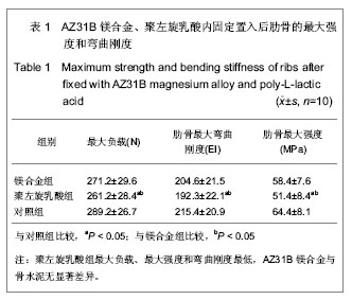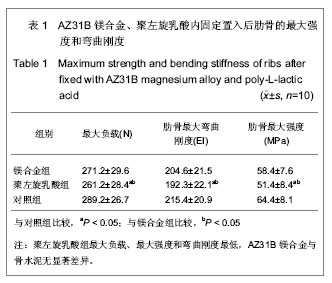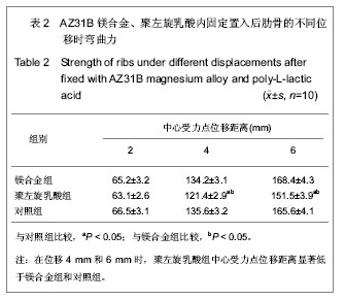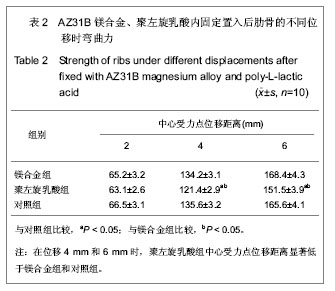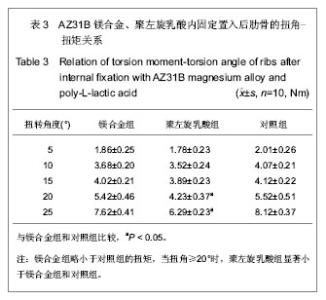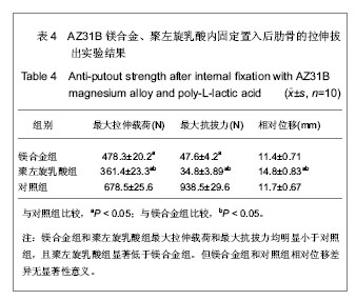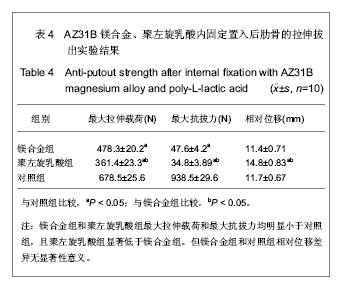| [1] Nirula R, Diaz JJ Jr, Trunkey DD, et al.Rib fracture repair: indications, technical issues, and future directions. World J Surg.2009;33(1):14-22.
[2] 王波,汤秉洪,王剑波.多发肋骨骨折的手术治疗分析[J].局解手术学杂志,2013,03:315-316.
[3] 陈万忠,苏红玲,杨凯,等.纯钛爪形肋骨接骨板在肋骨骨折复位中的应用[J].中国医药指南,2013,15:227-228.
[4] 舒骏,丛伟,薛洋,等.手术内固定治疗连枷胸的临床研究[J].华西医学,2013,04:517-519.
[5] 刘晋梁,李克耀,何建宁.可吸收肋骨钉在多发性肋骨骨折内固定中的应用[J].中国修复重建外科杂志,2011,25(1):100-103.
[6] 杨杰,刘斌,金健,等.可吸收髓内钉与记忆合金环抱器治疗多根、多处肋骨骨折的对照试验[J].吉林医学,2013,16:3121- 3122.
[7] 郭磊,刘魁,高晓宇,等.磷酸钙涂层的AZ31B镁合金材料对成骨细胞功能的影响[J].中国现代医学杂志,2009,19(2):161-163.
[8] 刘魁,郭磊,黄晶晶,等.AZ31B镁合金植入小鼠的生物相容性考察[J].中国生物工程杂志,2008,28(3):59-63.
[9] 王宪涛,郭磊,柴宏伟,等.氟化镁涂层AZ31B镁合金体内成骨作用的研究[J].中国医科大学学报,2011,40(10):870-873.
[10] Alkan A, Metin M, Ozden B, et al. Biomechanical comparison of plating techniques for fractures of the mandibular condyle. Br J Oral Maxillofac Surg. 2007;45(2):145-149.
[11] Jukkala Partio K, Pohjonen T, Laitinen O, et al. Biodegradation and st rength retention of poly L lactide screws in vivo. An experimental long term study in sheep. Ann Chir Gynaecol. 2001;90(3):219-224.
[12] Marasco SF, Liovic P, Sutalo ID. Structural integrity of intramedullary rib fixation using a single bioresorbable screw. J Trauma Acute Care Surg. 2012;73(3):668-673.
[13] Vyhnánek F, Skála P, Skrabalová D. A contribution of multidetector computed tomography to indications for chest wall stabilisation in multiple rib fractures. Acta Chir Orthop Traumatol Cech. 2011;78(3):258-261.
[14] Moreno De La Santa Barajas P, Polo Otero MD, Delgado Sánchez-Gracián C, et al. Surgical fixation of rib fractures with clips and titanium bars (STRATOS System). Preliminary experience. Cir Esp. 2010;88(3):180-186.
[15] Guo Y, Ren L, Liu C, et al. Effect of implantation of biodegradable magnesium alloy on BMP-2 expression in bone of ovariectomized osteoporosis rats. Mater Sci Eng C Mater Biol Appl. 2013;33(7):4470-4474.
[16] Wang J, Qin L, Wang K, et al. Cytotoxicity studies of AZ31D alloy and the effects of carbon dioxide on its biodegradation behavior in vitro. Mater Sci Eng C Mater Biol Appl. 2013; 33(7):4416-4426.
[17] Zhao X, Shi LL, Xu J, et al. Mg-Zn-Y alloys with long-period stacking ordered structure: In vitro assessments of biodegradation behavior. Mater Sci Eng C Mater Biol Appl. 2013;33(7):3627-3637.
[18] Yang X, Yin Q, Zhang Y, et al. Biocompatibility of silicon containing micro-arc oxidation coated magnesium alloy ZK60 with osteoblasts cultured in vitro. Zhongguo Xiu Fu Chong Jian Wai Ke Za Zhi. 2013;27(5):612-618.
[19] Hong D, Saha P, Chou DT, et al. In vitro degradation and cytotoxicity response of Mg-4% Zn-0.5% Zr (ZK40) alloy as a potential biodegradable material. Acta Biomater. 2013;9(10): 8534-8547.
[20] Windhagen H, Radtke K, Weizbauer A, et al. Biodegradable magnesium-based screw clinically equivalent to titanium screw in hallux valgus surgery: short term results of the first prospective, randomized, controlled clinical pilot study. Biomed Eng Online. 2013;12:62.
[21] Staiger MP, Pietak AM, Huadmai J,et al. Magnesium and its alloys as orthopedic biomaterials: a review. Biomaterials. 2006;27(9):1728-1734.
[22] Reifenrath J, Angrisani N, Erdmann N, et al. Degrading magnesium screws ZEK100: biomechanical testing, degradation analysis and soft-tissue biocompatibility in a rabbit model. Biomed Mater. 2013;8(4):045012.
[23] Chou DT, Hong D, Saha P, et al. In vitro and in vivo corrosion, cytocompatibility and mechanical properties of biodegradable Mg-Y-Ca-Zr alloys as implant materials. Acta Biomater. 2013; S1742-7061(13):00317-6.
[24] Johnson I, Liu H. A study on factors affecting the degradation of magnesium and a magnesium-yttrium alloy for biomedical applications. PLoS One. 2013;8(6):e65603.
[25] Sun J, Wang J, Jiang H, et al. In vivo comparative property study of the bioactivity of coated Mg-3Zn-0.8Zr alloy. Mater Sci Eng C Mater Biol Appl. 2013;33(6):3263-3272.
[26] Bondarenko A, Angrisani N, Meyer-Lindenberg A, et al. Magnesium-based bone implants: Immunohistochemical analysis of peri-implant osteogenesis by evaluation of osteopontin and osteocalcin expression. J Biomed Mater Res A. 2013 Jun 13.
[27] Ullmann B, Reifenrath J, Seitz JM, et al. Influence of the grain size on the in vivo degradation behaviour of the magnesium alloy LAE442. Proc Inst Mech Eng H. 2013;227(3):317-326.
[28] Kubásek J, Vojtěch D. Structure, mechanical properties, corrosion behavior and cytotoxicity of biodegradable Mg-X (X=Sn, Ga, In) alloys. Mater Sci Eng C Mater Biol Appl. 2013; 33(4):2421-2432.
[29] 王勇平,蒋垚. 基于SCI数据库收录文献分析镁合金植入物在骨科的应用[J].中国组织工程研究,2012,16(16):2971-2980.
[30] 齐峥嵘,张强,殷毅,等. 可降解镁合金作为骨植入材料的体内研究进展[J]. 中国修复重建外科杂志,2012,26(11):1381-1386.
[31] Lee JB, Park HN, Ko WK, et al. Poly(L-lactic acid)/ hydroxyapatite nanocylinders as nanofibrous structure for bone tissue engineering scaffolds. J Biomed Nanotechnol. 2013;9(3):424-429.
[32] Asano K, Matsuno T, Tabata Y, et al. Preparation of thermoplastic poly(l-lactic Acid) membranes for guided bone regeneration. Int J Oral Maxillofac Implants. 2013;28(4): 973-981.
[33] Zartner P, Cesnjevar R, Singer H,et al.First successful implantation of a biodegradable metal stent into the left pulmonary artery of a preterm baby. Catheter Cardiovasc Interv. 2005;66(4):590-594.
[34] Janning C, Willbold E, Vogt C, et al. Magnesium hydroxide temporarily enhancing osteoblast activity and decreasing the osteoclast number in peri-implant bone remodell ing. Acta Biomater. 2010;6(5):1861-1868.
[35] Wu LH, Wang LG, Wang P, et al. Superplasticity and deformation mechanism of Mg-7.0 AI-0.2 Zn alloys. Rare Metal Materials and Engineering. 2010;39(2):194-198. |
